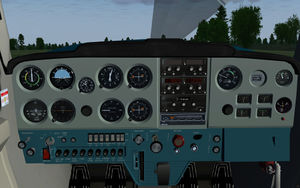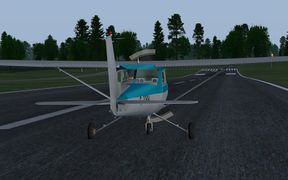Cessna 150
Jump to navigation
Jump to search
| Work in progress This article or section will be worked on in the upcoming hours or days. Note: The C150 is now (20160504) under maintenance by HJ See history for the latest developments. |
 | |
|---|---|
 | |
 | |
| Type | Civil aircraft, Civil utility aircraft, Trainer aircraft |
| Configuration | High wing aircraft, Fixed gear aircraft, Tricycle landing gear aircraft |
| Propulsion | Propeller aircraft, Single-engine aircraft |
| Manufacturer | Cessna |
| Author(s) | Harald Johnsen |
| FDM | JSBSim |
| --aircraft= | c150 |
| Status | Early production |
| FDM |
|
| Systems |
|
| Cockpit |
|
| Model |
|
| Development | |
| Website |
|
| Repository |
|
| Download |
|
| License | GPLv2+ |
|
| |
The Cessna 150 is a two-seat tricycle gear general aviation aircraft, that was designed for flight training, touring and personal use.
The Cessna 150 is the third most produced civilian plane ever, with 23,839 aircraft produced. The Cessna 150 was offered for sale in the 150 basic model, Commuter, Commuter II, Patroller and the aerobatic Aerobat models.
Normal Operating Procedures
Airspeeds for normal flight operation
| Vias | ||
|---|---|---|
| NORMAL / OPTIMUM | kts | MPH |
| Best angle of climb VX | 56 | 64 |
| Best rate of climb VY | 68 | 78 |
| Normal rotation speed VR | 50 | 58 |
| Normal climb speed | 65-75 | 75-85 |
| Normal landing (no flaps) | 60-70 | 70-80 |
| Normal landing (full flaps) | 50-60 | 57-69 |
| Powered landing (no flaps) | 65 | 75 |
| Powered landing (full flaps) | 55 | 63 |
| Maximum performance approach | 52 | 60 |
| Optimum glide speed | 60 | 69 |
| Vias | ||
|---|---|---|
| LIMITS | kts | MPH |
| Never Exceed Speed VNE Do not exceed this speed in any operation |
141 | 162 |
| Max structural speed VNO Do no exceed this speed except in smooth air and then only with caution |
107 | 123 |
| Maneuvering speed VA | ||
| 1,600 pounds | 67 | 111 |
| 1,450 pounds | 93 | 107 |
| 1,300 pounds | 88 | 101 |
| Maximum flap extended speed VFE | 85 | 97 |
| Stall speed VS | 47 | 54 |
| Stall speed (10° Flaps) VS1 | 45 | 52 |
| Stall speed in landing configuration VS0 | 42 | 49 |
| Optimum glide speed | 60 | 69 |
Checklist
Startup
- Seat - Lock
- Avionics -Off
- Carburetor Heat - Cold
- Mixture - Full Rich
- Primer - As Required
- Brakes
- Master - On
- Beacon - On
- Mags - Both
- Throttle - Open 1/4 inch
- Propeller Area - Clear
- Starter - On
- Oil Pressure
- Lights - As Required
- Mixture - As Required
Takeoff
- Wing flaps - Up
- Carburetor Heat - Cold
- Throttle - Full "Open"
- Elevator Control - Lift nose wheel at 50 mph
- Climb Speed - 72 MPH until all obstacles are cleared
Climb
- Air Speed - 75 to 80 MPH
- Power - Full throttle
- Mixture - Rich (unless engine is rough)
Cruise
- Power - 2000 to 2750 RPM
- Elevator Trim - Adjust
- Mixture - Lean to maximum RPM
Approach
- Mixture - Rich
- Carburetor Heat - Apply full heat before closing throttle
- Airspeed - 65 to 75 MPH
- Wing Flaps - As desired below 100 MPH
- Airspeed - 60 to 70 MPH with flaps extended
Landing
- Touch down - Main wheels first
- Landing Roll - Lower nose wheel gently
- Braking - Minimum required
Keyboard reminder
| Key | Function |
|---|---|
| d/⇧ Shift+d | Door select |
| Ctrl+d | Open/close selected door |
| ⇧ Shift+O | Operate priming pump |
| = | Open configuration dialog |
Gallery
External links
| ||||||||
